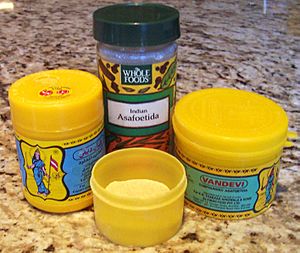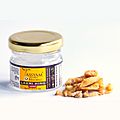Asafoetida facts for kids
Asafoetida (also spelled asafetida) is a dried plant sap. It comes from the roots of several types of Ferula plants. These plants are perennial herbs, meaning they live for more than two years. They can grow about 1 to 1.5 meters (3 to 5 feet) tall. Ferula plants belong to the celery family, called Apiaceae.
Asafoetida is native to the deserts of Iran and the mountains of Afghanistan. It has a very strong, pungent smell, which is why it's sometimes called "stinking gum." But don't worry! When you cook with it, the strong smell goes away. In cooked food, it adds a smooth flavor. Many people say it tastes a bit like leeks or onions. Because of its strong smell, asafoetida is also known as "devil's dung" or "food of the devils."
Contents
What's in a Name?
The English name "asafoetida" comes from two parts. "Asa" is a Latin word from the Persian word "azā," which means 'mastic' (a type of plant resin). "Foetidus" is a Latin word meaning 'smelling' or 'fetid,' which points to its strong, sulfur-like smell.
In some places, people might say "asafedity." Its powerful smell has given it many unusual names. For example, in French, it's called merde du Diable, which means 'Devil's dung.'
What is Asafoetida Made Of?
Asafoetida is a mix of different things. It usually contains:
- About 40–64% resin (a sticky plant substance)
- 25% natural gum
- 10–17% volatile oil (this is what gives it its strong smell)
- A small amount of wood ash
The strong smell and flavor of asafoetida come mainly from special compounds in its oil. These are called organosulfides. Some of these are also found in garlic and cooked onions.
Where Does it Come From?
Many different types of Ferula plants are used to make asafoetida. Most of these plants have sulfur-containing compounds in their essential oils, which create the unique smell.
Some of the main Ferula species that produce asafoetida include:
- Ferula foetida: Found in Eastern Iran, western Afghanistan, western Pakistan, and Central Asia.
- Ferula assa-foetida: Grows in Southern Iran. This species is often thought to be the main source, but many other Ferula types are also used.
- Other species like Ferula pseudalliacea, Ferula rubricaulis, Ferula lutensis, Ferula alliacea, Ferula latisecta, Ferula sinkiangensis, and Ferula fukanensis are also sources in different regions, especially in Iran and China.
- Ferula narthex: Native to Afghanistan, northern Pakistan, and Kashmir.
How is it Used?
Cooking
Asafoetida is a popular spice used in cooking, especially in Indian cuisine. It helps with digestion and adds a savory flavor to food. It's often used in vegetarian dishes, especially as a substitute for onion and garlic.
You'll find it in many Indian lentil curries like dal, chickpea curries, and vegetable dishes, especially those with potato and cauliflower. In Indian cooking, a tiny bit of asafoetida is quickly heated in hot oil before being added to the food. This helps to bring out its flavor and reduce its strong smell. It can also help balance sweet, sour, salty, and spicy tastes in a dish. Sometimes, a tiny amount of dried and ground asafoetida is mixed with salt and eaten with raw salads.
In its pure form, asafoetida comes in chunks of resin. You only need to scrape off a small amount to use. The smell of the pure resin is so strong that it can make other spices smell like it if not stored in an airtight container!
How is it Grown and Made?
The resin-like natural gum comes from the dried sap that is taken from the stem and roots of the Ferula plant. This sap is then used as a spice. When it's fresh, the resin is greyish-white. But as it dries, it turns a dark amber color.
Pure asafoetida resin is hard to grind. Traditionally, people would crush it between stones or with a hammer. Today, you can usually buy asafoetida as a fine powder. This powder is often mixed with other ingredients like rice flour or white wheat flour (called maida) and gum arabic. This makes it easier to use and helps to dilute its strong flavor.
The Ferula assa-foetida plant can grow up to 2 meters (6.5 feet) tall. It has large leaves and hollow flowering stems. All parts of the plant, including the roots, have that distinct strong smell.
A Look Back in Time
Asafoetida was known in the early Mediterranean region. It traveled there by land from Iran. It first came to Europe with Alexander the Great's army. They thought they had found a plant similar to silphium, a famous herb from North Africa that is now extinct.
A writer named Pedanius Dioscorides wrote in the first century that the Iranian asafoetida was not as strong as silphium but could be used in cooking. This was lucky because silphium soon disappeared. Asafoetida then became more popular with doctors and cooks.
Asafoetida is also mentioned in old Jewish literature, like the Mishnah. Famous Jewish scholar Maimonides even wrote about eating it in the rainy season.
Even though it's not very common in Europe today, asafoetida is still widely used in India. Some religious groups, like Brahmins and Jains, use it as a substitute for onion and garlic, which they are not allowed to eat. Followers of Hare Krishna also use asafoetida because they do not eat onions or garlic. Their food is offered to Lord Krishna, and onions and garlic are not allowed in these offerings.
Many Arab and Islamic scientists also wrote about asafoetida. Avicenna discussed how it affects digestion. Other scholars described its positive effects on the breathing system.
After the Roman Empire fell, asafoetida became rare in Europe until the 16th century. It was mostly seen as a medicine. Some Europeans thought its smell would ruin any dish. But Garcia de Orta, a Portuguese doctor, explained that it was widely used in India for both medicine and cooking. During the Italian Renaissance, asafoetida was even used in some exorcism rituals.
Images for kids





